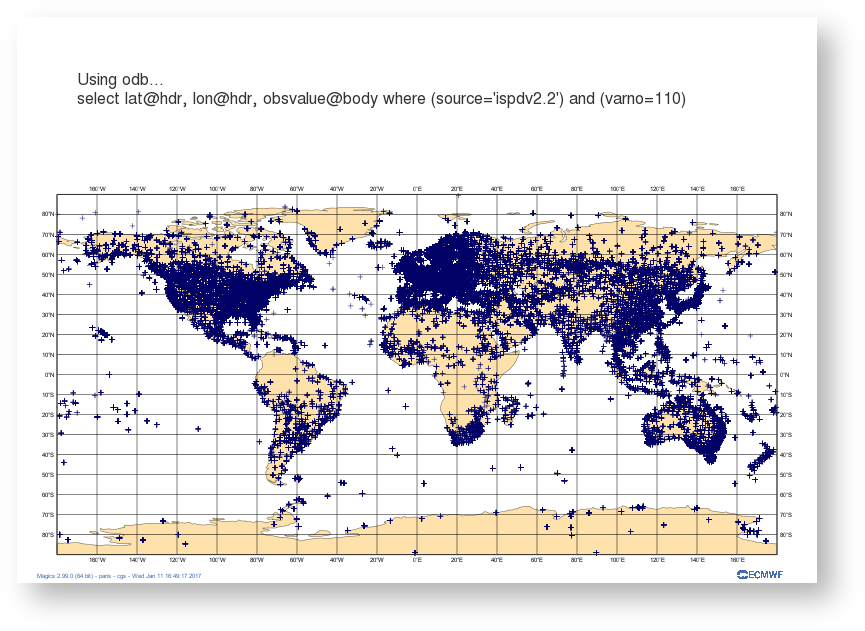| Panel | ||
|---|---|---|
| ||
There are several ways on visualisating ODB data in Magics.
This page will present examples of these different plottings, and will offer skeletons of python programs.
|
Using an ODB file and create a geographical map
In this example, we have downloaded some ODB data from Mars.
The mars request looks like:
| Code Block | ||
|---|---|---|
| ||
retrieve,
class = e2,
type = ofb,
stream = oper,
expver = 1607,
repres = bu,
reportype = 16005,
obstype = 1,
date = 20100101,
time = 0,
domain = g,
target = "data.odb",
filter = "select lat@hdr, lon@hdr, obsvalue@body where (source='ispdv2.2') and (varno=110)",
duplicates = keep |
We retrieve 3 columns lat@hdr, lon@hdr, obsvalue@body. In that case obsvalue@body will contain the value of the Surface pressure in Pascal.
We can dump the result :
| Code Block | ||
|---|---|---|
| ||
lat@hdr lon@hdr obsvalue@body 84.559998 -44.100006 100180.000000 84.349998 -46.989990 100140.000000 83.610001 -89.299988 100380.000000 83.419998 -71.970001 100140.000000 83.300003 -69.040009 100090.000000 82.480003 -93.190002 100350.000000 82.449997 -170.309998 101510.000000 82.260002 -128.949997 99180.000000 81.449997 -144.850006 100180.000000 81.419998 -144.619995 100180.000000 81.400002 -145.550003 100250.000000 80.709999 -110.500000 100180.000000 80.320000 -179.860001 102969.992188 80.019997 -151.399994 100440.000000 |
In this example, we will ask Magics to load this ODB file, and plot the position of each observation using the simple marker. WE have to inform Magics about the name of the columns to use to find the latitude, and longitude information.
| Section | |||||||||||||||||||
|---|---|---|---|---|---|---|---|---|---|---|---|---|---|---|---|---|---|---|---|
|
Now, we are going to colour the symbol according to the value of the observation. The advanced mode for symbol plotting offers an easy way to specify range and colours, we add a legend for readability.
| Section | |||||||||||||||||||
|---|---|---|---|---|---|---|---|---|---|---|---|---|---|---|---|---|---|---|---|
|

